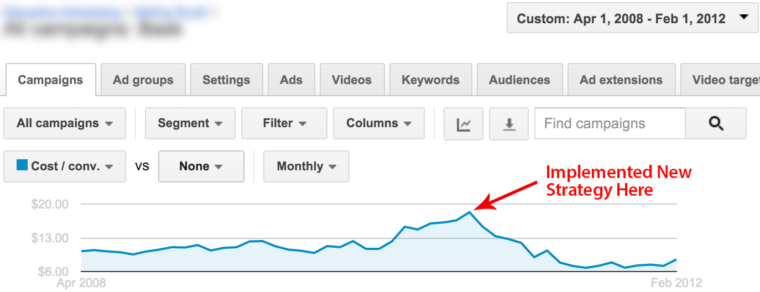By most financial accounts, Christopher Columbus’s first transatlantic voyage was a tremendous loss.
The trip took over five weeks. Columbus failed to find a route to the Orient, returned with little gold or spices and lost the largest of this three ships, the Santa Maria, off the coast of Haiti.
The second voyage was another matter entirely. This time, Columbus set out with 17 ships, crossed the ocean in a mere 21 days and established long-lasting European colonies on the new continent.
The difference? Now he knew where he was going.
Sadly, I’ve seen businesses spend years navigating the turbulent seas of online marketing with no more guidance than the Santa Maria…and with basically the same outcome.
The good news is, they don’t have to. There is a map available—it’s called “analytics.”
What Does Analytics Contribute?
Now, that word…“analytics”…might prompt an eye roll or two.
Analytics is often seen as a purely academic exercise. On the surface, the performance of your marketing doesn’t seem to change at all because it’s being measured.
After all, when was the last time a customer said, “I chose to buy your product because I knew my transaction would be so well documented?”
But despite this, according to HubSpot’s 2015 State of Inbound Report, companies that implement effective marketing analytics are 12 times more likely to increase their year-over-year return.
So, there is financial value to analytics, but where does it come from?
There are three main ways that analytics data can improve your marketing performance:
- Identifying wasted spending
- Avoiding opportunity costs
- Finding new growth areas
Let’s take a look at each of these.
1. Identifying Wasted Spending
Last year, we helped out a new client whose PPC marketing looked a bit like Columbus’ first voyage. It was a valiant effort—in three months, their campaigns garnered almost 100,000 clicks and over 17,000 conversions.
And yet, inexplicably, they were losing money.
Boldly, they had pushed on, increasing their marketing budget another 30%. But the problem persisted.
When we started working with the company, we immediately dove into their analytics data. As with Columbus’s original trip, it turned out that their campaigns were covering a lot of distance without making any real progress.
Here’s what their results looked like for the past 90 days:

Unfortunately, while this client’s AdWords campaigns were producing a ton of clicks and conversions, only about 1 in 100 of the conversions actually turned into a paying customer.
That meant all those clicks weren’t making money…they were draining it. The cost-per-lead was $20.29, but the cost per sale was around $2,000, making the campaigns unprofitable.
In this situation, it was clear that spending more on marketing was not the answer—spending more was like trying to drain water from your boat by drilling a hole in the bottom.
You can’t lose money on every sale and expect to make it up in volume—what this company really needed to do was get rid of the leaks.
I used their analytics data to track down the search terms in each campaign that produced clicks but not sales. All in all, the company was wasting 42% of their budget ($49,000/month) on these pointless clicks.
It was a simple matter to remove these keywords from the company’s campaigns. No sales were lost, but stopping the $49,000 drain drove cost per lead down to $11.86, and cost per sale to $1,200.
Suddenly the company was profitable again!
Why Track ROI
In this case, it was analytics that saved the day.
On the surface, everything looked great—lots of clicks, lots of conversions. It wasn’t until we followed those clicks and conversions all the way through to return on investment (ROI) that we were able to identify which parts of the campaigns were profitable and which weren’t.
Surprisingly, 48% of companies don’t track revenue from their campaigns at all and only 21% do it effectively.
The other 79% of companies really have no idea whether their marketing is making money or not, so they have to rely on intuition or experience to make their decisions.
Sounds to me like a great way to steer your company off the edge of the world.
I’m all for experience, but just because I’m experienced and say I could drive home with my eyes closed doesn’t mean I’d actually try it!
2. Avoiding Opportunity Cost
Let’s return to my client’s story for a moment.
Analytics didn’t just tell them what campaign parts were unprofitable—it identified the profitable ones too.
If the company reinvested their 42% savings into these most-effective areas, they likely would have seen an extra 4,150 leads and 41 sales per month.
Opportunity costs like this are not unique. Every PPC campaign has more and less profitable parts. You’ll want to steal from the poor and give to the rich, but only analytics knows which is which.
3. Finding New Growth Areas
Part of the reason Columbus’ second voyage was so much more successful was the fact that he now knew what the new world really looked like.
It wasn’t full of silk or spices, but it was rich in pineapples, coffee beans, tobacco, and a host of other unexpected imports.
Good analytics can also help you to identify previously unrecognized opportunities in your market. In addition to telling you what is being clicked, you can also learn a lot about who is clicking.
Think about your own business. Would you change your marketing if you found out most of your customers:
- Were over 55 years old
- Lived in urban areas
- Had no college education
- Were men
- Had a certain pain point
- Found you because of a friend’s recommendation
The more you know about the groups and subgroups within your customer base, the better you can customize your content to meet their needs.
Now, many companies feel that they already know this information without going to the trouble of teasing it out with analytics. After all, they started the business with a certain niche in mind, so when sales come it’s only reasonable to assume that the intended market must be the one responding…right?
Well, sometimes, it’s not that reasonable of an assumption.
Remember, Columbus didn’t actually find India. He found something totally different, but very worthwhile. The same thing can happen with your marketing campaigns.
Case Study
For example, a few years back, I helped one of my early clients use unanticipated customer information to significantly improve the performance of their AdWords campaigns.
They had a small company of 25 employees and were trying to edge their way into a highly competitive market.
The competition was so intense, in fact, that over the previous 12 months the cost-per-click and cost-per-conversion for their campaigns had doubled.
I’d helped to shore up the leaks in their accounts and they were very good at turning conversions into sales, so they were still making money, but it was difficult to stay profitable as their cost-per-click continued to rise.
Rather than resign myself to the status quo, I searched through their analytics data for new options and made a startling discovery.
A significant percentage of their conversions came from a set of keywords that—on the surface—seemed unrelated to their current offering.
It was a different customer profile, which meant that my client needed to address different pain points than most of their marketing was focused on.
This group of customers had not only been overlooked by my client, but also by the competition, so the keywords were converting for 67% less than the rest of our keywords.
I started building new marketing campaigns around this new market profile immediately. Unchallenged by the competition, we began to see scores of new conversions and sales and cost-per-conversion plummeted.

Soon, the company’s biggest problem was finding enough sales people to floor all of their qualified leads. The company grew to 250 employees and soon made over $5 million in VC profit.
See how powerful your analytics data can be?
Conclusion
Analytics may not be the most exciting way to drive online marketing results, but it can be one of the most effective routes to increased profitability.
Like a map to the new world, well-tracked marketing is not an end unto itself—it’s the jumping-off point for effective, intelligent, targeted business.
It teaches you where your money comes from and where it goes. And knowing that can make hundreds of thousands of dollars of difference.
The only question is, are you using your analytics data to keep your marketing campaigns on course?
Image Credits
Featured Image: komisar/DepositPhotos.com
In-post Photo: Buster Keaton GIF created by Austin Andrus. Used with permission.
All screenshots by Jacob Baadsgaard. Taken September 2016.





